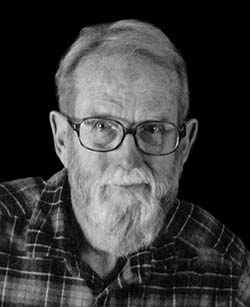 |
 |
| current issue |  | past issues |  | send a letter/news |  | address update |  | advertise |  | about us |  | alumni home |
In Memoriam
|
Winslow Caughey '48, '49G
He was a scientist driven by curiosity. By Chelsea Conaboy '04 |
|
 Winslow Caughey '48, '49G had a choice early in life, according to family lore. He could pursue chemistry. Or he could become an opera singer.
Winslow Caughey '48, '49G had a choice early in life, according to family lore. He could pursue chemistry. Or he could become an opera singer.
Despite his strong baritone, Caughey chose science and lived a life shaped by the unflagging curiosity that had led him to such a diversity of talents. He died Feb. 25, at age 86, of pneumonia after years of lung trouble. In a career that spanned half a century, Caughey published more than 200 scientific papers, while pursuing hobbies that included boat building, raising cattle, and casually reciting lines from comic opera masters Gilbert and Sullivan. "He was incredibly curious, and he championed curiosity in all of us," says Byron Caughey, his son and one of four children.
Growing up in Antrim, N.H., Winslow was surrounded by music, often singing with family and friends around a piano. He began his studies in chemical engineering at UNH at age 15 but was recruited by the Navy to work on radar systems. He returned to finish his degree and earned a master's in chemistry as well before going on to receive his doctorate in chemistry at Johns Hopkins University.
There, he met Helen Hill, whom he long referred to—tongue firmly in cheek—as the "woman so privileged as to be my wife." In 1956, the couple founded the Monadnock Research Institute in Antrim, where Caughey focused on synthesizing compounds called porphyrins, then suspected of being useful against cancer. The family followed academic appointments to south Florida and Arizona, returning for the summers to a cabin in Antrim. In 1973, Caughey was hired as chairman of biochemistry at Colorado State University.
Caughey insisted on Sunday as a family day, often spent outdoors or building something—a sailboat or the television that would serve as the family's set for 20 years. And he was a source of mischief, says daughter Joan Gorga of Antrim, leading his children and then grandchildren in friendly pranks, or routinely hiding his wife's morning coffee. Later, in the more than four years after his wife was paralyzed by a back surgery gone wrong, he spent each day by her side. She died in 2011.
Caughey had retired from Colorado State in 1995, and the couple moved to Montana, where Byron is an investigator at a National Institutes of Health laboratory studying a group of diseases that includes what is commonly known as mad cow. The elder Caughey began volunteering in the lab and suggested to the researchers that porphyrins might be effective against transmission of the diseases. The compounds worked. The professor, retired but not finished, shared authorship on a series of papers with his son.
Return to In Memoriam
blog comments powered by Disqus
